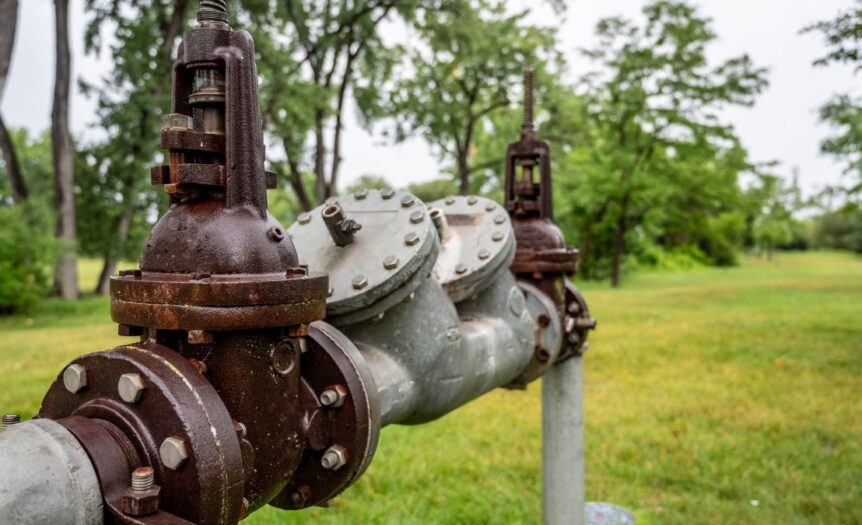Did you know that, before 1974, unprotected plumbing cross-connection was entirely legal? Read on to learn a brief and interesting history of backflow prevention,the basics of backflow prevention, and the future of backflow preventer technology.
What Is Backflow Prevention?
Backflow prevention involves specific devices—conveniently named backflow preventers—to stop pollution and contamination caused by backflowing pipeline conditions from compromising potable water supplies. Normal plumbing conditions maintain a particular flow of water direction, with the help of pressure.
However, interruptions to this pressure can cause water to flow backward and re-enter public drinking water. Thankfully, pressure-sensitive backflow preventers monitor pipeline conditions and activate shut-off valves during backflow episodes, effectively protecting cross-connections.
The First Backflow Preventers
The very first backflow preventers were developed and implemented throughout Los Angeles in the 1930s. These devices featured a pressure vacuum breaker (PVB) assembly, a common design for modern backflow preventers today!
Despite the invention of PVBs, the widespread use of backflow preventers in American cities didn’t become more prevalent for many decades. However, following multiple backflow-related tragedies (most prominently the 1933 Amoebic Dystenty outbreak at the World’s Fair in Chicago), many large municipalities began implementing PVBs and related equipment into their plumbing systems. And in 1974, the Safe Drinking Water Act was passed into law and mandated that all unprotected cross-connections be eliminated or protected with a backflow prevention device.
Since the 70s, potable water supply laws and regulations have only become more effective and stringent. More importantly, backflow preventer technology is better than ever in human history!
Current and Future Outlooks
Along with the aforementioned PVBs, the most common modern backflow preventer designs are double-check valve assemblies (DCVA) and reduced pressure zone (RPZ) assemblies. However, both DCVAs and RPZs feature superior protections for cross-connections and vulnerable plumbing infrastructure. For example, DCVAs feature an additional check valve and chamber to ensure accurate shut-off responses to backflowing conditions.
Alternatively, RPZs often boast a pressure sensing line and bypass relief valve to effectively combat high-hazard plumbing systems (chemical processing plants and hospitals, for example). But where will backflow preventer technology go from here?
Most industry experts believe advancements in reliability, performance, and materials are the most likely improvements over the next few decades. For instance, 100-percent stainless steel backflow preventers are quickly replacing less-durable devices.
This brief and interesting history of backflow prevention highlights the importance of these devices within our society. Ensure your property or business has the correct backflow prevention equipment in place to protect your community from water-related complications effectively.





 Deering Estate
Deering Estate
 Massage Envy South Miami
Massage Envy South Miami
 Calla Blow Dry
Calla Blow Dry
 My Derma Clinic
My Derma Clinic
 Sushi Maki
Sushi Maki
 Sports Grill
Sports Grill
 The Healthy Kitchen
The Healthy Kitchen
 Golden Rule Seafood
Golden Rule Seafood
 Malanga Cuban Café
Malanga Cuban Café

 Kathleen Ballard
Kathleen Ballard
 Panter, Panter & Sampedro
Panter, Panter & Sampedro
 Vintage Liquors
Vintage Liquors
 The Dog from Ipanema
The Dog from Ipanema
 Rubinstein Family Chiropractic
Rubinstein Family Chiropractic
 Your Pet’s Best
Your Pet’s Best
 Indigo Republic
Indigo Republic




 ATR Luxury Homes
ATR Luxury Homes


 2112 Design Studio
2112 Design Studio
 Hamilton Fox & Company
Hamilton Fox & Company
 Creative Design Services
Creative Design Services
 Best Pest Professionals
Best Pest Professionals
 HD Tree Services
HD Tree Services
 Trinity Air Conditioning Company
Trinity Air Conditioning Company
 Cisca Construction & Development
Cisca Construction & Development
 Mosquito Joe
Mosquito Joe
 Cutler Bay Solar Solutions
Cutler Bay Solar Solutions


 Miami Royal Ballet & Dance
Miami Royal Ballet & Dance
 Christopher Columbus
Christopher Columbus
 Pineview Preschools
Pineview Preschools
 Westminster
Westminster
 Carrollton
Carrollton
 Lil’ Jungle
Lil’ Jungle
 Frost Science Museum
Frost Science Museum
 Palmer Trinity School
Palmer Trinity School
 South Florida Music
South Florida Music
 Pinecrest Orthodontics
Pinecrest Orthodontics
 Dr. Bob Pediatric Dentist
Dr. Bob Pediatric Dentist
 d.pediatrics
d.pediatrics
 South Miami Women’s Health
South Miami Women’s Health

 The Spot Barbershop
The Spot Barbershop
 My Derma Clinic
My Derma Clinic




 Miami Dance Project
Miami Dance Project

 Rubinstein Family Chiropractic
Rubinstein Family Chiropractic
 Indigo Republic
Indigo Republic

 Safes Universe
Safes Universe
 Vintage Liquors
Vintage Liquors
 Evenings Delight
Evenings Delight





 Atchana’s Homegrown Thai
Atchana’s Homegrown Thai
 Baptist Health South Florida
Baptist Health South Florida

 Laser Eye Center of Miami
Laser Eye Center of Miami
 Visiting Angels
Visiting Angels
 OpusCare of South Florida
OpusCare of South Florida

 Your Pet’s Best
Your Pet’s Best





 HD Tree Services
HD Tree Services
 Hamilton Fox & Company
Hamilton Fox & Company


 Creative Design Services
Creative Design Services